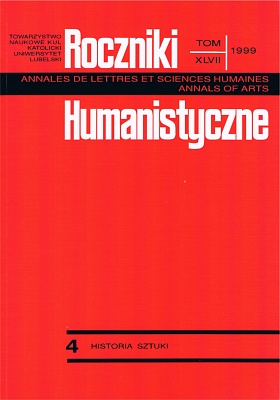Andrzej Okińczyc - „The Master and the Slave of the Portrait”
Abstract
Andrzej Okińczyc, born in 1949, will celebrate his fiftieth birthday in 1999 and for that very reason at least we should pose a question concerning the place established by the creative outcome of the Poznań artist in the most contemporary history of Polish painting, still regarded as one the so called young generation of Polish painters. Okińczyc is an artist best know for his portraits and selfportraits although he can be associated with the works of art that Tadeusz Nyczek calls “images of deception and reflection” as well as “frescos on walls”. Up till now he has had asignificant number of individual exhibitions both in Poland and abroad along with accompanying catalogues, he has also taken part in important group exhibitions devoted particularly to portraits. What is, then, and where is the place for Okińczyc's works in the melting pot of continuously arising means of expression or marking of one's individual artistic line, often pretending to be either innovative or revelational, of one's character eventually aiming at discovering or establishing what is the key issue for an artist – his own style? Okińczyc first of all paints the man. He is not afraid to be classical in his compositions or even academic, without a pejorative meaning of the word. In the case of the Poznań painter the term “classical” has abearing not only on his works' quality, but their character as well. His artistic creativity seems to be that of neoacademic. The drawing is maximally faithful to nature
in his studies of nudes, draperies and still lifes), replacing aphotograph. There seem to be two elements constituting his paintings: one, the drawing, which is academic and the other, the subject matter, which is nonacademic. He focuses on everyday reality of his workshop, his environment and flat. His works reveal certain qualities rather unique nowadays, such as modesty, the balance of emotional charges, harmony and typically classical egocentricity. Okińczyc does not register the surrounding reality, rather the rediscovers it anew, to his own private use, while executing his own interpretation via the painter's means. The portrait becomes not only a masterpiece of amodelling form and composition but also an interpretation of the man. All elements in a portrait cofunction harmoniously: the background, facial expression, look, pose, dress as well as the frame which constitutes an integral part of the whole composition. A particulary distinctive feature of Okińczyc's portraits is avery soft modelling form with afull range of changing chiaroscuro producing the effect of smoky veils and mists. It seems that acertain group of Okińczyc's portraits stands in proximity with the achievements of the Wprost group, represented, for instance, by Leszek Sobocki's canvas who found inspiration in the paintings of Jacek Malczewski and transformed them in aseries of selfportraits. Okińczyc has been and still is the master and the slave of the portrait, be it the images of his relatives, friends and acquaintances. He has always been the painter of himself and always in his own, Okińczyc-like manner.
Copyright (c) 1999 Roczniki Humanistyczne

This work is licensed under a Creative Commons Attribution-NonCommercial-NoDerivatives 4.0 International License.





